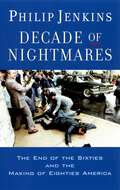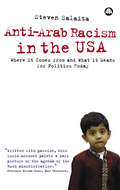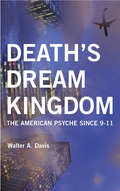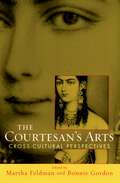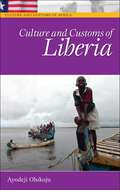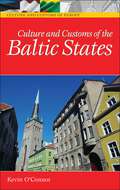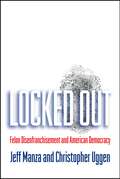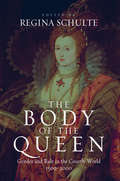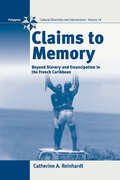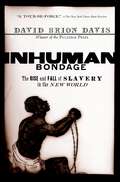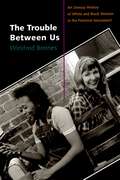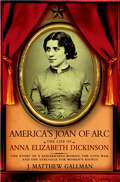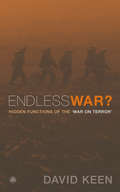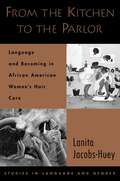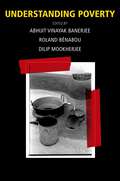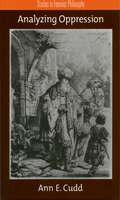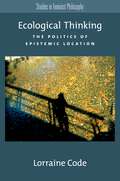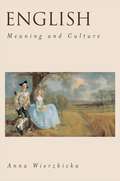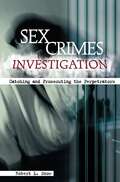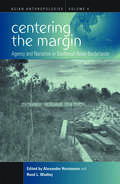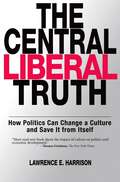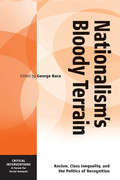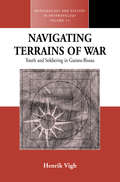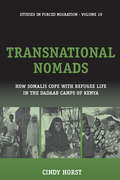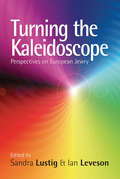- Table View
- List View
Decade of Nightmares: The End of the Sixties and the Making of Eighties America
by Philip JenkinsWhy did the youthful optimism and openness of the sixties give way to Ronald Reagan and the spirit of conservative reaction--a spirit that remains ascendant today? Drawing on a wide array of sources--including tabloid journalism, popular fiction, movies, and television shows--Philip Jenkins argues that a remarkable confluence of panics, scares, and a few genuine threats created a climate of fear that led to the conservative reaction. He identifies 1975 to 1986 as the watershed years. During this time, he says, there was a sharp increase in perceived threats to our security at home and abroad. At home, America seemed to be threatened by monstrous criminals--serial killers, child abusers, Satanic cults, and predatory drug dealers, to name just a few. On the international scene, we were confronted by the Soviet Union and its evil empire, by OPEC with its stranglehold on global oil, by the Ayatollahs who made hostages of our diplomats in Iran. Increasingly, these dangers began to be described in terms of moral evil. Rejecting the radicalism of the '60s, which many saw as the source of the crisis, Americans adopted a more pessimistic interpretation of human behavior, which harked back to much older themes in American culture. This simpler but darker vision ultimately brought us Ronald Reagan and the ascendancy of the political Right, which more than two decades later shows no sign of loosening its grip. Writing in his usual crisp and witty prose, Jenkins offers a truly original and persuasive account of a period that continues to fascinate the American public. It is bound to captivate anyone who lived through this period, as well as all those who want to understand the forces that transformed--and continue to define--the American political landscape.
Anti-Arab Racism in the USA: Where It Comes From and What It Means For Politics Today
by Steven SalaitaToday is a difficult time to be both Arab and American. Since 9/11 there has been a lot of criticism of America’s involvement in the middle east. Yet there has been little analysis of how America treats citizens of Arab or middle eastern origin within its own borders. *BR**BR*Steven Salaita explores the reality of Anti-Arab racism in America. He blends personal narrative, theory and polemics to show how this deep-rooted racism affects everything from legislation to cultural life, shining a light on the consequences of Anti-Arab racism both at home and abroad.*BR**BR*The book shows how ingrained racist attitudes can be found within the progressive movements on the political left, as well as the right. Salaita argues that, under the guise of patriotism, Anti-Arab racism fuels support for policies such as the Patriot Act.
Death's Dream Kingdom: The American Psyche Since 9-11
by Walter A. DavisWhy is fear a dominant emotion in contemporary society? Why are politicians using words like 'terror', 'evil' and 'fundamentalism', and what effect is it having on public consciousness?*BR**BR*This book taps into the cultural psyche to explore the link between ideology and emotional and psychological manipulation. It shows that the Bush administration has been hugely successful in controlling and developing a new political climate through the creation of an almost hypnotic mass consciousness. *BR**BR*From the sado-masochist hysteria of Mel Gibson's The Passion of the Christ‚ to the atrocities at Abu Ghraib prison; and from the genocidal use of depleted uranium in Iraq to the apocalyptic language driving the Christian Right's assault on basic human rights.*BR**BR*Davis's findings take us to the heart of the ideological paralysis of the Left, while offering an innovative approach to understanding contemporary history.
The Courtesan's Arts: Cross-Cultural Perspectives
by Martha Feldman Bonnie GordonCourtesans, hetaeras, tawaif-s, ji-s--these women have exchanged artistic graces, elevated conversation, and sexual favors with male patrons throughout history and around the world. Of a different world than common prostitutes, courtesans deal in artistic and intellectual pleasures in ways that are wholly interdependent with their commerce in sex. In pre-colonial India, courtesans cultivated a wide variety of artistic skills, including magic, music, and chemistry. In Ming dynasty China, courtesans communicated with their patrons through poetry and music. Yet because these cultural practices have existed primarily outside our present-day canons of art and have often occurred through oral transmission, courtesans' arts have vanished almost without trace. The Courtesan's Arts delves into this hidden legacy, unveiling the artistic practices and cultural production of courtesan cultures with a sideways glance at the partly-related geisha. Balancing theoretical and empirical research, this interdisciplinary collection is the first of its kind to explore courtesan cultures through diverse case studies--the Edo period and modern Japan, 20th-century Korea, Ming dynasty China, ancient Greece, early modern Italy, and India, past and present. Each essay puts forward new perspectives on how the arts have figured in the courtesan's survival or demise. Though performative and often flamboyant, courtesans have been enigmatic and elusive to their beholders--including scholars. They have shaped cultures through art, yet their arts, often intangible, have all but faded from view. Often courtesans have hovered in the crevices of space, time, and practice--between gifts and money, courts and cities, feminine allure and masculine power, as substitutes for wives but keepers of culture. Reproductively irrelevant, they have tended to be ambiguous figures, thriving on social distinction while operating outside official familial relations. They have symbolized desirability and sophistication yet often been reviled as decadent. The Courtesan's Arts shows that while courtesans cultures have appeared regularly in various times and places, they are universal neither as a phenomenon nor as a type. To the contrary, when they do crop up, wide variations exist. What binds together courtesans and their arts in the present-day post-industrialized world of global services and commodities is their fragility. Once vital to cultures of leisure and pleasure, courtesans are now largely forgotten, transformed into national icons or historical curiosities, or reduced to prostitution.
Culture and Customs of Liberia (Culture and Customs of Africa)
by Ayodeji OlukojuLiberia has a strong connection to the United States in that it was founded by former slaves in 1822. Although Liberia had existed as an independent African nation and a symbol of hope to the African peoples under the rule of various colonial powers, its recent history has been bedeviled by a prolonged upheaval following a military coup d'etat in 1980. In this context, the narrative highlights the distinctiveness of Liberians in their negotiation of traditional indigenous and modern practices, and the changes wrought by Christianity and Western influences.
Culture and Customs of the Baltic States (Culture and Customs of Europe)
by Kevin C. Ph.D.The Baltic States of Estonia, Latvia, and Lithuania are thriving after hundreds of years of German colonization, numerous wars of conquest, and demographic Russification. Their cultures have survived, perhaps through a conscious effort to sustain many of their most ancient customs and traditions. Though the Baltic States are responding to modern and postmodern international trends, contemporary developments in the region's cultural life are part of an ongoing conversation about the way in which the Balts understand their histories, destinies, and national identities. This timely overview of the reemerging states portrays the Estonians, Latvians, and Lithuanians as they see themselves—through a historical lens.The Baltic States of Estonia, Latvia, and Lithuania are thriving after hundreds of years of German colonization, numerous wars of conquest, and demographic Russification. Their cultures have survived, perhaps through a conscious effort to sustain many of their most ancient customs and traditions. Though the Baltic States are responding to modern and postmodern international trends, contemporary developments in the region's cultural life are part of an ongoing conversation about the way in which the Balts understand their own histories, destines, and national identities. This timely overview of the reemerging states portrays the Estonians, Latvians, and Lithuanians as they see themselves—through a historical lens.The approach in each of the topical chapters is to generalize what is common among the three states and then to focus on each country in turn. Chapters on the land, people, and history; religion; marriage, family, gender, and education; holidays, cuisine, and leisure activities; language, folklore, and literature; media and cinema; performing arts; and art are a superb introduction to the Baltics and to the unique aspects of the countries. Lithuania's culture has been heavily influenced by Poland, and the capital, Vilnius, was a thriving center of Jewish learning until the Nazi years. Latvia is the most ethnically diverse and Russian-influenced. Estonia sees itself as a European country, indeed, Scandinavian.
Locked Out: Felon Disenfranchisement and American Democracy (Studies in Crime and Public Policy)
by Jeff Manza Christopher Uggen5.4 million Americans--1 in every 40 voting age adults-- are denied the right to participate in democratic elections because of a past or current felony conviction. In several American states, 1 in 4 black men cannot vote due to a felony conviction. In a country that prides itself on universal suffrage, how did the United States come to deny a voice to such a large percentage of its citizenry? What are the consequences of large-scale disenfranchisement--both for election outcomes, and for public policy more generally? Locked Out exposes one of the most important, yet little known, threats to the health of American democracy today. It reveals the centrality of racial factors in the origins of these laws, and their impact on politics today. Marshalling the first real empirical evidence on the issue to make a case for reform, the authors' path-breaking analysis will inform all future policy and political debates on the laws governing the political rights of criminals.
The Body of the Queen: Gender and Rule in the Courtly World, 1500-2000
by Regina SchulteHow many “bodies” does a queen have? What is the significance of multiple “bodies”? How has the gendered body been constructed and perceived within the context of the European courts during the course of the past five centuries? These are some of the questions addressed in this anthology, a contribution to the ongoing debate provoked by Ernst H. Kantorowicz in his seminal work from 1957, The King’s Two Bodies. On the basis of both textual self-presentations and visual representations a gradual transformation of the queen appears: A sacred/providential figure in medieval and early modern period, an ideal bourgeois wife during the late-18th and 19th Centuries, and a star-like (re-) presentation of royalty during the past century. Twentieth-century mass media has produced the celebrity and film star queens personified by the contested and enigmatic Nefertiti of ancient Egypt, the mysterious Elizabeth (Sisi) of Austria, Grace Kelly as Queen of both Hollywood and Monaco and Romy Schneider as the invented Empress.
Claims to Memory: Beyond Slavery and Emancipation in the French Caribbean (Polygons: Cultural Diversities and Intersections #10)
by Catherine ReinhardtWhy do the people of the French Caribbean still continue to be haunted by the memory of their slave past more than one hundred and fifty years after the abolition of slavery? What process led to the divorce of their collective memory of slavery and emancipation from France's portrayal of these historical phenomena? How are Martinicans and Guadeloupeans today transforming the silences of the past into historical and cultural manifestations rooted in the Caribbean? This book answers these questions by relating the 1998 controversy surrounding the 150th anniversary of France's abolition of slavery to the period of the slave regime spanning the late Enlightenment and the French Revolution. By comparing a diversity of documents—including letters by slaves, free people of color, and planters, as well as writings by the philosophes, royal decrees, and court cases—the author untangles the complex forces of the slave regime that have shaped collective memory. The current nationalization of the memory of slavery in France has turned these once peripheral claims into passionate political and cultural debates.
Inhuman Bondage: The Rise and Fall of Slavery in the New World
by David Brion DavisDavid Brion Davis has long been recognized as the leading authority on slavery in the Western World. His books have won every major history award--including the Pulitzer Prize and the National Book Award--and he has been universally praised for his prodigious research, his brilliant analytical skill, and his rich and powerful prose. Now, in Inhuman Bondage, Davis sums up a lifetime of insight in what Stanley L. Engerman calls "a monumental and magisterial book, the essential work on New World slavery for several decades to come." Davis begins with the dramatic Amistad case, which vividly highlights the international character of the Atlantic slave trade and the roles of the American judiciary, the presidency, the media, and of both black and white abolitionists. The heart of the book looks at slavery in the American South, describing black slaveholding planters, the rise of the Cotton Kingdom, the daily life of ordinary slaves, the highly destructive internal, long-distance slave trade, the sexual exploitation of slaves, the emergence of an African-American culture, and much more. But though centered on the United States, the book offers a global perspective spanning four continents. It is the only study of American slavery that reaches back to ancient foundations (discussing the classical and biblical justifications for chattel bondage) and also traces the long evolution of anti-black racism (as in the writings of David Hume and Immanuel Kant, among many others). Equally important, it combines the subjects of slavery and abolitionism as very few books do, and it illuminates the meaning of nineteenth-century slave conspiracies and revolts, with a detailed comparison with 3 major revolts in the British Caribbean. It connects the actual life of slaves with the crucial place of slavery in American politics and stresses that slavery was integral to America's success as a nation--not a marginal enterprise. A definitive history by a writer deeply immersed in the subject, Inhuman Bondage offers a compelling narrative that links together the profits of slavery, the pain of the enslaved, and the legacy of racism. It is the ultimate portrait of the dark side of the American dream. Yet it offers an inspiring example as well--the story of how abolitionists, barely a fringe group in the 1770s, successfully fought, in the space of a hundred years, to defeat one of human history's greatest evils.
The Trouble Between Us: An Uneasy History of White and Black Women in the Feminist Movement
by Winifred BreinesInspired by the idealism of the civil rights movement, the women who launched the radical second wave of the feminist movement believed, as a bedrock principle, in universal sisterhood and color-blind democracy. Their hopes, however, were soon dashed. To this day, the failure to create an integrated movement remains a sensitive and contested issue. In The Trouble Between Us, Winifred Breines explores why a racially integrated women's liberation movement did not develop in the United States. Drawing on flyers, letters, newspapers, journals, institutional records, and oral histories, Breines dissects how white and black women's participation in the movements of the 1960s led to the development of separate feminisms. Herself a participant in these events, Breines attempts to reconcile the explicit professions of anti-racism by white feminists with the accusations of mistreatment, ignorance, and neglect by African American feminists. Many radical white women, unable to see beyond their own experiences and idealism, often behaved in unconsciously or abstractly racist ways, despite their passionately anti-racist stance and hard work to develop an interracial movement. As Breines argues, however, white feminists' racism is not the only reason for the absence of an interracial feminist movement. Segregation, black women's interest in the Black Power movement, class differences, and the development of identity politics with an emphasis on "difference" were all powerful factors that divided white and black women. By the late 1970s and early 1980s white feminists began to understand black feminism's call to include race and class in gender analyses, and black feminists began to give white feminists some credit for their political work. Despite early setbacks, white and black radical feminists eventually developed cross-racial feminist political projects. Their struggle to bridge the racial divide provides a model for all Americans in a multiracial society.
America's Joan of Arc: The Life of Anna Elizabeth Dickinson
by J. Matthew GallmanOne of the most celebrated women of her time, a spellbinding speaker dubbed the Queen of the Lyceum and America's Joan of Arc, Anna Elizabeth Dickinson was a charismatic orator, writer, and actress, who rose to fame during the Civil War and remained in the public eye for the next three decades. J. Matthew Gallman offers the first full-length biography of Dickinson to appear in over half a century. Gallman describes how Dickinson's passionate patriotism and fiery style, coupled with her unabashed abolitionism and biting critiques of antiwar Democrats--known as Copperheads--struck a nerve with her audiences. In barely two years, she rose from an unknown young Philadelphia radical, to a successful New England stump speaker, to a true national celebrity. At the height of her fame, Dickinson counted many of the nation's leading reformers, authors, politicians, and actors among her friends. Among the dozens of famous figures who populate the narrative are Susan B. Anthony, Whitelaw Reid, William Lloyd Garrison, Frederick Douglass, Elizabeth Cady Stanton, and Harriet Beecher Stowe. Gallman shows how Dickinson's life illuminates the possibilities and barriers faced by nineteenth-century women, revealing how their behavior could at once be seen as worthy, highly valued, shocking, and deviant.
Endless War?: Hidden Functions of the 'War on Terror'
by David KeenWas the Iraq war really an act of goodwill to liberate people from injustice? Or was it a strategic move to maintain US dominance globally? *BR**BR*This book casts a critical light on the real motives behind war and conflict. David Keen explores how winning war is rarely an end in itself; rather, war tends to be part of a wider political and economic game that is consistent with strengthening the enemy. Keen devises a radical framework for analysing an unending war project, where the 'war on terror' is an extension of the Cold War.*BR**BR*The book draws on the author's detailed study of wars in Sudan, Sierra Leone, as well as in a range of other conflicts.
From the Kitchen to the Parlor: Language and Becoming in African American Women's Hair Care (Studies in Language and Gender)
by Lanita Jacobs-HueyWhen is hair "just hair" and when is it not "just hair"? Documenting the politics of African American women's hair, this multi-sited linguistic ethnography explores everyday interaction in beauty parlors, Internet discussions, comedy clubs, and other contexts to illuminate how and why hair matters in African American women's day-to-day experiences.
Understanding Poverty
by Abhijit Vinayak Banerjee Roland Benabou Dilip MookherjeeUnderstanding poverty and what to do about it, is perhaps the central concern of all of economics. Yet the lay public almost never gets to hear what leading professional economists have to say about it. This volume brings together twenty-eight essays by some of the world leaders in the field, who were invited to tell the lay reader about the most important things they have learnt from their research that relate to poverty. The essays cover a wide array of topics: the first essay is about how poverty gets measured. The next section is about the causes of poverty and its persistence, and the ideas range from the impact of colonialism and globalization to the problems of "excessive" population growth, corruption and ethnic conflict. The next section is about policy: how should we fight poverty? The essays discuss how to get drug companies to produce more vaccines for the diseases of the poor, what we should and should not expect from micro-credit, what we should do about child labor, how to design welfare policies that work better and a host of other topics. The final section is about where the puzzles lie: what are the most important anomalies, the big gaps in the way economists think about poverty? The essays talk about the puzzling reluctance of Kenyan farmers to fertilizers, the enduring power of social relationships in economic transactions in developing countries and the need to understand where aspirations come from, and much else. Every essay is written with the aim of presenting the latest and the most sophisticated in economics without any recourse to jargon or technical language.
Analyzing Oppression (Studies in Feminist Philosophy)
by Ann E. CuddAnalyzing Oppression presents a new, integrated theory of social oppression, which tackles the fundamental question that no theory of oppression has satisfactorily answered: if there is no natural hierarchy among humans, why are some cases of oppression so persistent? Cudd argues that the explanation lies in the coercive co-opting of the oppressed to join in their own oppression. This answer sets the stage for analysis throughout the book, as it explores the questions of how and why the oppressed join in their oppression. Cudd argues that oppression is an institutionally structured harm perpetrated on social groups by other groups using direct and indirect material, economic, and psychological force. Among the most important and insidious of the indirect forces is an economic force that operates through oppressed persons' own rational choices. This force constitutes the central feature of analysis, and the book argues that this force is especially insidious because it conceals the fact of oppression from the oppressed and from others who would be sympathetic to their plight. The oppressed come to believe that they suffer personal failings and this belief appears to absolve society from responsibility. While on Cudd's view oppression is grounded in material exploitation and physical deprivation, it cannot be long sustained without corresponding psychological forces. Cudd examines the direct and indirect psychological forces that generate and sustain oppression. She discusses strategies that groups have used to resist oppression and argues that all persons have a moral responsibility to resist in some way. In the concluding chapter Cudd proposes a concept of freedom that would be possible for humans in a world that is actively opposing oppression, arguing that freedom for each individual is only possible when we achieve freedom for all others.
Ecological Thinking: The Politics of Epistemic Location (Studies in Feminist Philosophy)
by Lorraine CodeHow could ecological thinking animate an epistemology capable of addressing feminist, multicultural, and other post-colonial concerns? Starting from an epistemological approach implicit in Rachel Carson's scientific practice, Lorraine Code elaborates the creative, restructuring resources of ecology for a theory of knowledge. She critiques the instrumental rationality, abstract individualism, and exploitation of people and places that western epistemologies of mastery have legitimated, to propose a politics of epistemic location, sensitive to the interplay of particularity and diversity, and focused on responsible epistemic practice. Drawing on ecological theory and practice, on naturalized epistemology, and on feminist and post-colonial theories, Code analyzes extended examples from developmental psychology, and from two "natural" institutions of knowledge production--medicine and law. These institutions lend themselves well to a reconfigured naturalism. They are, in practice, empirically-scientifically informed, specifically situated, and locally interpretive. With human subjects as their "objects" of knowledge, they invoke the responsibility requirements central to Code's larger project. This book discusses a wide range of literature in philosophy, social science, and ethico-political thought. Highly innovative, it will generate productive conversations in feminist theory, and in the ethics and politics of knowledge more broadly conceived.
English: Meaning and Culture
by Anna WierzbickaIt is widely accepted that English is the first truly global language and lingua franca. Anna Wierzbicka, the distinguished linguist known for her theories of semantics, has written the first book that connects the English language with what she terms "Anglo" culture. Wierzbicka points out that language and culture are not just interconnected, but inseparable. She uses original research to investigate the "universe of meaning" within the English language (both grammar and vocabulary) and places it in historical and geographical perspective. This engrossing and fascinating work of scholarship should appeal not only to linguists and others concerned with language and culture, but the large group of scholars studying English and English as a second language.
Sex Crimes Investigation: Catching and Prosecuting the Perpetrators
by Robert L. SnowNo one wants to be robbed at gunpoint, or have his car stolen, or his house robbed. When these crimes happen, victims may feel angry, afraid, or violated. But there is no violation quite so devastating as sexual assault. Victims do not recover easily—either emotionally, psychologically, or physically from such incidents, and the long-term impact can have devastating effects on the victims, their families, and communities. Investigating sexually based crimes is particularly difficult for many reasons. Often the collection of evidence requires a medical examination of the victim—a second violation of sorts. Police must interview the victim, who must recount his or her assault. Often, the victims are children, and offenders range from family members to perfect strangers. But investigating and prosecuting these crimes is crucial to the healing process of many victims, and to the safety of society at large.Detective Snow takes readers on a tour of the ways in which the police investigate and help prosecute such crimes. Each chapter begins with a real-life incident and throughout the book real stories are used to illustrate each step in the process. Snow addresses the processing of the crime scene, the collection of evidence, the development of suspects, the questioning of witnesses and perpetrators, and the preparation for trial. Few members of the public have any idea how complex and delicate the investigation of sex crimes really is. This book sheds light on this important police work and helps readers understand how these crimes are investigated, solved, and prosecuted. Victims and their families will especially benefit from the information in this book, but all readers will gain insight into the crimes, their incidence, their impact on victims, and the way the criminal justice system responds, from the scene of the crime through the capture and incarceration of the perpetrators.
Centering the Margin: Agency and Narrative in Southeast Asian Borderlands (Asian Anthropologies #4)
by Alexander Horstmann Reed L. WadleyIn a completely new approach to borders and border crossing, this volume suggests a re-conceptualization of the nation in Southeast Asia. Choosing an actor approach, the individual chapters in this volume capture the narratives of minorities, migrants and refugees who inhabit and cross borders as part of their everyday life. They show that people are not only constrained by borders; the crossing of borders also opens up new options of agency. Making active use of these, border-crossing actors construct their own live projects on the border in multiple ways against the original intention of the nation-state. Based on their intimate knowledge of the interaction of communities, anthropologists from Europe, the USA, Japan and Southeast Asia provide a vivid picture of the effects of state policies at the borders on these communities.
The Central Liberal Truth: How Politics Can Change a Culture and Save It from Itself
by Lawrence E. HarrisonWhich cultural values, beliefs, and attitudes best promote democracy, social justice, and prosperity? How can we use the forces that shape cultural change, such as religion, education, and political leadership, to promote these values in the Third World--and for underachieving minorities in the First World? In this book, Lawrence E. Harrison offers intriguing answers to these questions, in a valuable follow-up to his acclaimed Culture Matters. Drawing on a three-year research project that explored the cultural values of dozens of nations--from Botswana, Sweden, and India to China, Egypt, and Chile--Harrison offers a provocative look at values around the globe, revealing how each nation's culture has propelled or retarded their political and economic progress. The book presents 25 factors that operate very differently in cultures prone to progress and those that resist it, including one's influence over destiny, the importance attached to education, the extent to which people identify with and trust others, and the role of women in society. Harrison pulls no punches, and many of his findings are controversial. Contradicting the arguments of multiculturalists, this book contends that when it comes to promoting human progress, some cultures are clearly more effective than others. It convincingly shows which values, beliefs, and attitudes work and how we can foster them. "Harrison takes up the question that is at the center of politics today: Can we self-consciously change cultures so they encourage development and modernization?" --David Brooks, New York Times "I can think of no better entrance to the topic, both for what it teaches and the way it invites and prepares the reader to continue. A gateway study." --David S. Landes, author of The Wealth and Poverty of Nations
Nationalism's Bloody Terrain: Racism, Class Inequality, and the Politics of Recognition (Critical Interventions: A Forum for Social Analysis #8)
As many scholars have argued, racism and its passions are created by and subordinated to the nation. This volume places the practices of racism at the center of analysis of so-called post-racist or multi cultural nation-states. This way, each contributor analytically treats racism and its related concepts of race, identity, culture, and naturalizing symbols of blood to highlight the manner in which governing institutions use nationalist precepts to create "races". In the end, it is racism - the actual political practices of domination - that makes "race" salient, especially in its multi-cultural and liberal-democratic form.
Navigating Terrains of War: Youth and Soldiering in Guinea-Bissau (Methodology & History in Anthropology #13)
by Henrik E. VighThrough the concept of "social navigation," this book sheds light on the mobilization of urban youth in West Africa. Social navigation offers a perspective on praxis in situations of conflict and turmoil. It provides insights into the interplay between objective structures and subjective agency, thus enabling us to make sense of the opportunistic, sometimes fatalistic and tactical ways in which young people struggle to expand the horizons of possibility in a world of conflict, turmoil and diminishing resources.
Transnational Nomads: How Somalis Cope with Refugee Life in the Dadaab Camps of Kenya (Forced Migration #19)
by Cindy HorstThere is a tendency to consider all refugees as 'vulnerable victims': an attitude reinforced by the stream of images depicting refugees living in abject conditions. This groundbreaking study of Somalis in a Kenyan refugee camp reveals the inadequacy of such assumptions by describing the rich personal and social histories that refugees bring with them to the camps. The author focuses on the ways in which Somalis are able to adapt their 'nomadic' heritage in order to cope with camp life; a heritage that includes a high degree of mobility and strong social networks that reach beyond the confines of the camp as far as the U.S. and Europe.
Turning the Kaleidoscope: Perspectives on European Jewry
by Sandra Lustig Ian LevesonFar from being a blank space on the Jewish map, or a void in the Jewish cultural world, post-Shoah Europe is a place where Jewry has continued to develop, even though it is facing different challenges and opportunities than elsewhere. Living on a continent characterized by highly diverse patterns of culture, language, history, and relations to Jews, European Jewry mirrors that kaleidoscopic diversity. This volume explores such key questions as the new roles for Jews in Europe; models of Jewish community organization in Europe; concepts of diaspora and galut; a European-Jewish way of life in the era of globalization; and European Jews' relationship to Israel and to non-Jews. Some contributions highlight experiences of Jews in Britain, Sweden, Norway, Hungary, Austria, Germany, and the Netherlands. Helping us to understand the special and common characteristics of European Jewry, this collection offers a valuable contribution to the continued rebuilding of Jewish life in the postwar era.
